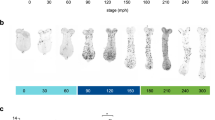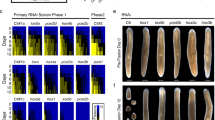Abstract
It is currently debated whether segmentation in different animal phyla has a common origin and shares a common genetic mechanism1,2. The apparent use of different genetic networks in arthropods and vertebrates has become a strong argument against a common origin of segmentation. Our knowledge of arthropod segmentation is based mainly on the insect Drosophila, in which a hierarchical cascade of transcription factors controls segmentation3,4. The function of some of these genes seems to be conserved among arthropods, including spiders5,6, but not vertebrates1,6,7,8. The Notch pathway has a key role in vertebrate segmentation (somitogenesis) but is not involved in Drosophila body segmentation1,7,9. Here we show that Notch and Delta genes are involved in segmentation of another arthropod, the spider Cupiennius salei. Expression patterns of Notch and Delta, coupled with RNA interference experiments, identify many similarities between spider segmentation and vertebrate somitogenesis. Our data indicate that formation of the segments in arthropods and vertebrates may have shared a genetic programme in a common ancestor and that parts of this programme have been lost in particular descendant lineages.
This is a preview of subscription content, access via your institution
Access options
Subscribe to this journal
Receive 51 print issues and online access
$199.00 per year
only $3.90 per issue
Buy this article
- Purchase on Springer Link
- Instant access to full article PDF
Prices may be subject to local taxes which are calculated during checkout



Similar content being viewed by others
References
Davis, G. K. & Patel, N. H. The origin and evolution of segmentation. Trends Genet. 15, M68–M72 (1999)
De Robertis, E. M. Evolutionary biology. The ancestry of segmentation. Nature 387, 25–26 (1997)
St Johnston, D. & Nüsslein-Volhard, C. The origin of pattern and polarity in the Drosophila embryo. Cell 68, 201–219 (1992)
Pankratz, M. & Jäckle, H. in Development of Drosophila melanogaster (eds Bate, M. & Martnez-Arias, A.) 467–516 (Cold Spring Harbor Laboratory Press, Cold Spring Harbor, New York, 1993)
Damen, W. G. M., Weller, M. & Tautz, D. The expression patterns of hairy, even-skipped, and runt in the spider Cupiennius salei imply that these genes were segmentation genes in a basal arthropod. Proc. Natl Acad. Sci USA 97, 4515–4519 (2000)
Damen, W. G. M. Parasegmental organization of the spider embryo implies that the parasegment is an evolutionary conserved entity in arthropod embryogenesis. Development 129, 1239–1250 (2002)
Saga, Y. & Takeda, H. The making of a somite: molecular events in vertebrate segmentation. Nature Rev. Genet. 2, 835–845 (2001)
Pourquié, O. Notch around the clock. Curr. Opin. Genet. Dev. 9, 559–565 (1999)
Conlon, R. A., Reaume, A. G. & Rossant, J. Notch1 is required for the coordinate segmentation of the somites. Development 121, 1533–1545 (1995)
Aguinaldo, A. M. et al. Evidence for a clade of nematodes, arthropods and other moulting animals. Nature 387, 489–493 (1997)
Holley, S. A., Julich, D., Rauch, G. J., Geisler, R. & Nüsslein-Volhard, C. her1 and the notch pathway function within the oscillator mechanism that regulates zebrafish somitogenesis. Development 129, 1175–1183 (2002)
Holley, S. A., Geisler, R. & Nüsslein-Volhard, C. Control of her1 expression during zebrafish somitogenesis by a delta-dependent oscillator and an independent wave-front activity. Genes Dev. 14, 1678–1690 (2000)
Palmeirim, I., Henrique, D., Ish-Horowicz, D. & Pourquie, O. Avian hairy gene expression identifies a molecular clock linked to vertebrate segmentation and somitogenesis. Cell 91, 639–648 (1997)
Jouve, C. et al. Notch signalling is required for cyclic expression of the hairy-like gene HES1 in the presomitic mesoderm. Development 127, 1421–1429 (2000)
Jiang, Y. J. et al. Notch signalling and the synchronization of the somite segmentation clock. Nature 408, 475–479 (2000)
Stollewerk, A. Recruitment of cell groups through Delta/Notch signalling during spider neurogenesis. Development 129, 5339–5348 (2002)
Seitz, K.-A. Normale Entwicklung des arachniden Embryos Cupiennius salei Keyserling und seine Regulationsbefähigung nach Röntgenbestrahlungen. Zool. Jb. Anat. Bd. 83, 327–447 (1966)
Schoppmeier, M. & Damen, W. G. M. Double-stranded RNA-interference (RNAi) in the spider Cupiennius salei: the role of Distal-less is evolutionarily conserved in arthropod appendage formation. Dev. Genes Evol. 211, 76–82 (2001)
Oates, A. C. & Ho, R. J. Hairy/E(spl)-related (Her) genes are central components of the segmentation oscillator and display redundancy with the Delta/Notch signaling pathway in the formation of anterior segmental boundaries in the zebrafish. Development 129, 2929–2946 (2002)
Bessho, Y. et al. Dynamic expression and essential functions of Hes7 in somite segmentation. Genes Dev. 15, 2642–2647 (2001)
Dale, J. K. et al. Periodic Notch inhibition by Lunatic Fringe underlies the chick segmentation clock. Nature 421, 275–278 (2003)
Baonza, A. & Freeman, M. Notch signalling and the initiation of neural development in the Drosophila eye. Development 128, 3889–3998 (2001)
Jennings, B., Preiss, A., Delidakis, C. & Bray, S. The Notch signalling pathway is required for Enhancer of split bHLH protein expression during neurogenesis in the Drosophila embryo. Development 120, 3537–3548 (1994)
Davis, G. K. & Patel, N. H. Short, long and beyond: molecular and embryological approaches to insect segmentation. Annu. Rev. Entomol. 47, 669–699 (2002)
Anderson, D. T. Embryology and Phylogeny in Annelids and Arthropods 365–451 (Pergamin, Oxford, 1973)
Papayannopoulos, V., Tomlinson, A., Panin, V. M., Rauskolb, C. & Irvine, K. Dorsal-ventral signaling in the Drosophila eye. Science 281, 2031–2034 (1998)
Brook, W. J., Diaz-Benjumea, F. J. & Cohen, S. M. Organizing spatial pattern in limb development. Annu. Rev. Cell Dev. Biol. 12, 161–180 (1996)
de Celis, J. F., Tyler, D. M., de Celis, J. & Bray, S. J. Notch signalling mediates segmentation of the Drosophila leg. Development 125, 4617–4626 (1998)
Dearden, P. & Akam, M. A role for Fringe in segment morphogenesis but not segment formation in the grasshopper Schistocerca gregaria. Dev. Genes Evol. 210, 329–336 (2000)
Wiellette, E. L. & McGinnis, W. Hox genes differentially regulate Serrate to generate segment-specific structures. Development 126, 1985–1995 (1999)
Acknowledgements
We thank D, Tautz for support and discussion; S. Roth for comments on the manuscript; T. Klein for discussion; A. Pozhitkov for help with the statistic analysis; and R. Janßen for care of the spider culture. This work was partially supported by the Deutsche Forschungsgemeinschaft.
Author information
Authors and Affiliations
Corresponding author
Ethics declarations
Competing interests
The authors declare that they have no competing financial interests.
Supplementary information
Rights and permissions
About this article
Cite this article
Stollewerk, A., Schoppmeier, M. & Damen, W. Involvement of Notch and Delta genes in spider segmentation. Nature 423, 863–865 (2003). https://doi.org/10.1038/nature01682
Received:
Accepted:
Published:
Issue Date:
DOI: https://doi.org/10.1038/nature01682
This article is cited by
-
Eggs to long-legs: embryonic staging of the harvestman Phalangium opilio (Opiliones), an emerging model arachnid
Frontiers in Zoology (2022)
-
A chelicerate Wnt gene expression atlas: novel insights into the complexity of arthropod Wnt-patterning
EvoDevo (2021)
-
Genomic resources and toolkits for developmental study of whip spiders (Amblypygi) provide insights into arachnid genome evolution and antenniform leg patterning
EvoDevo (2020)
-
Elongation during segmentation shows axial variability, low mitotic rates, and synchronized cell cycle domains in the crustacean, Thamnocephalus platyurus
EvoDevo (2020)
-
Sex differences in spiders: from phenotype to genomics
Development Genes and Evolution (2020)
Comments
By submitting a comment you agree to abide by our Terms and Community Guidelines. If you find something abusive or that does not comply with our terms or guidelines please flag it as inappropriate.



